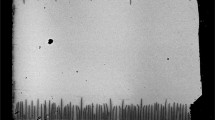Abstract
Due to stress, cracks appear in constructions: cracks appear in buildings, bridges, pavements, among other structures. In the long run, cracks need to be repaired. However, our resources are limited, so we need to decide which cracks are more dangerous. To make this decision, we need to be able to predict how different cracks will grow. There are several empirical formulas describing crack growth. In this paper, we show that by using scale invariance, we can provide a theoretical explanation for these empirical formulas. The existence of such an explanation makes us confident that the existing empirical formulas can (and should) be used in the design of the corresponding automatic decision systems.
Access this chapter
Tax calculation will be finalised at checkout
Purchases are for personal use only
Similar content being viewed by others
References
Aczel, J., Dhombres, J.: Functional Equations in Several Variables. Cambridge University Press, Cambridge, UK (2008)
Bigerelle, M., Iost, A.: Bootstrap analysis of FCGR, application to the Paris relationship and to lifetime prediction. Int. J. Fatigue 21, 299–307 (1999)
Broek, D.: Elementary Engineering Fracture Mechanics. Martinus Lojhoff Publishers, The Hague, The Netherlands (1984)
Carpinteri, A., Paggi, M.: Self-similarity and crack growth instability in the correlation between the Paris’ constants. Eng. Fract. Mech. 74, 1041–1053 (2007)
Cortie, M.B., Garrett, G.G.: On the correlation between the \(C\) and \(m\) in the Paris equation for fatigue crack propagation. J. Eng. Fract. Mech. 30(1), 49–58 (1988)
Little, D., Allen, D., Bhasin, A.: Modeling and Design of Flexible Pavements and Materials. Springer, Cham, Switzerland (2018)
Paris, P.S., Erdogan, F.: A critical analysis of crack propagation laws. J. Basic Eng. 85(4), 528–534 (1963)
Pugno, N., Ciavarella, M., Cornetti, P., Carpinteri, A.: A generalized Paris’ law for fatigue crack growth. J. Mech. Phys. Solids 54, 1333–1349 (2006)
Rodriguez Velasquez, E.D., Kreinovich, V., Kosheleva, O., Hoang Phuong, N.: How to Estimate the Stiffness of the Multi-Layer Road Based on Properties of Layers: Symmetry-Based Explanation for Odemark’s Equation, University of Texas at El Paso, Department of Computer Science, Technical Report UTEP-CS-20-49 (2020) http://www.cs.utep.edu/vladik/2020/tr20-49.pdf
Sheskin, D.E.: Handbook of Parametric and Non-Parametric Statistical Procedures. Chapman & Hall/CRC, London, UK (2011)
Acknowledgments
This work was supported in part by the US National Science Foundation grants 1623190 (A Model of Change for Preparing a New Generation for Professional Practice in Computer Science) and HRD-1242122 (Cyber-ShARE Center of Excellence).
The authors are greatly thankful to Ildar Batyrshin for his encouragement and to the anonymous referees for their useful suggestions.
Author information
Authors and Affiliations
Corresponding author
Editor information
Editors and Affiliations
Rights and permissions
Copyright information
© 2020 Springer Nature Switzerland AG
About this paper
Cite this paper
Velasquez, E.D.R., Kosheleva, O., Kreinovich, V. (2020). How to Decide Which Cracks Should Be Repaired First: Theoretical Explanation of Empirical Formulas. In: Martínez-Villaseñor, L., Herrera-Alcántara, O., Ponce, H., Castro-Espinoza, F.A. (eds) Advances in Soft Computing. MICAI 2020. Lecture Notes in Computer Science(), vol 12468. Springer, Cham. https://doi.org/10.1007/978-3-030-60884-2_30
Download citation
DOI: https://doi.org/10.1007/978-3-030-60884-2_30
Published:
Publisher Name: Springer, Cham
Print ISBN: 978-3-030-60883-5
Online ISBN: 978-3-030-60884-2
eBook Packages: Computer ScienceComputer Science (R0)





